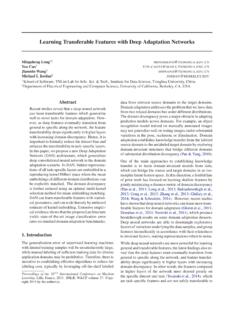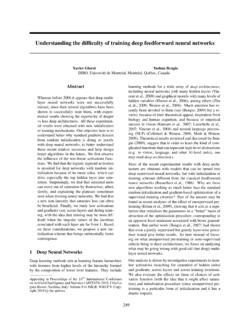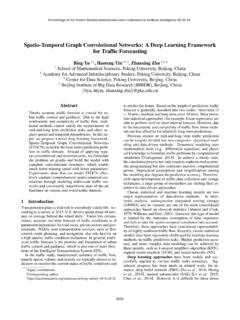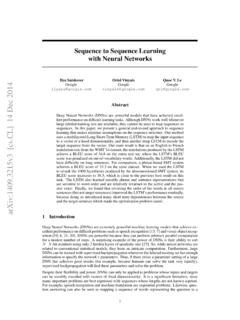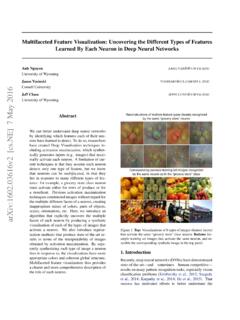Transcription of “Deep Fakes” using Generative Adversarial Networks (GAN)
1 deep Fakes using Generative Adversarial Networks (GAN). Tianxiang Shen Ruixian Liu Ju Bai Zheng Li UCSD UCSD UCSD UCSD. La Jolla, USA La Jolla, USA La Jolla, USA La Jolla, USA. Abstract deep Fakes is a popular image synthesis technique based on artificial intelligence. It is more powerful than tra- ditional image-to-image translation as it can generate im- ages without given paired training data. The goal of deep Fakes is to capture common characteristics from a collec- tion of existed images and to figure out a way of enduing other images with those characteristics, shapes and styles. Generative Adversarial Networks (GANs) provide us an available way to implement deep Fakes.
2 In this project, we use a Cycle-GAN network which is a combination of two GAN Networks . The loss can be divided Figure 1. A comparison between paired training images and un- into 2 parts: total generator loss LG and discriminator loss paired training images [4]. LD , where LG includes a cycle-consistency loss Lcyc to en- sure the images in input and output domains are mapped in a reasonable way. We calculate and back-propagate the 2 transfer method from a large training data set of numerous losses iteratively to train the Cycle-GAN. images to ensure the translation is reasonable for various We implement our Cycle-GAN for two objectives - ob- inputs [1, 2, 3].
3 Ject transfiguration and style transfer. In the former task However, during the training period, many training mod- we translate images of handbags and backpacks mutually els require paired training images. Yet obtaining paired and in the latter one we transform photos to other art styles training data can be difficult and expensive. For example, such as Van Gogh oil painting and Ukiyo-e. Making use building image pairs manually may be resource-consuming, of PyTorch framework, the results of generated images are but undefined output will emerge without paired constraints. relatively satisfying. Inspired by Zhu et al.'s work [4], we implement a Cycle- GAN system that can learn to translate between images without paired training images as inputs(Figure 1, right).
4 1. Introduction We test this Cycle-GAN system in two translation tasks, namely object transfiguration that translates images be- Background tween handbags and backpacks and style transfer which Image-to-image translation has been researched for a transforms between real photographs and different art styles long time by scientists from fields of computer vision, com- such as oil painting and Ukiyo-e. putational photography, image processing and so on. It has Previous Works a wide range of applications for entertainment and design- assistance. The basic principle of image translation can be Image-to-image translation has been investigated for a deemed as changing features of the input images in some long time.
5 Previously, it is usually carried out by manual specific ways while keeping other features unchanged. The or semi-automatic methods [5]. Such operations include method of feature change can be tuned manually or auto- enhancement of the contrast of pictures, image smoothing matically. For automatic change, a process based on ma- strategies, noise reduction techniques, and so on. In 2014, chine learning should be included for learning a general Goodfellow et al. developed image-to-image translation by 1. image generated by G is denoted as D(input). Obviously D(input) [0, 1]. We train D to maximize the probabil- ity that D assigns the correct labels to both real images and fake images generated by G, while G is being trained to minimize the probability that its outputs are determined by D as fake images, to minimize 1 D(G(z)).
6 This two- player minimax game between D and G can be expressed as the following value function [6]: min max V(D, G) = Ex pdata (x) [log D(x)]. G D. (1). + Ez pz (z) [log(1 D(G(z)))]. After a sufficient training, the generator should be able to produce quite realistic images by using noise signals z. Figure 2. A block diagram of a GAN Meanwhile, the discriminator's capability of distinguishing fake images from real ones will also be strengthened. using a Generative Adversarial network (GAN) significantly deep Convolutional GAN (DCGAN). [6]. The GAN system consists of a generator that gener- A convolutional GAN with a set of architecturally topo- ates images from random noises and a discriminator that logical constraints for stability of training is called a DC- judges whether an input image is authentic or produced by GAN [7].
7 Both the generator and the discriminator of a the generator. The two components are functionally adver- DCGAN are CNNs. In our work, the generator of a DC- sarial, and they play two Adversarial roles like a forger and GAN is a CNN which contains three down sampling layers, a detective literally. After the training period, the generator six residual layers and three up sampling layers (Figure 3), can produce fake images with high fidelity. In 2015, Rad- and the discriminator is another CNN which contains four ford et al. used a deep convolutional Generative Adversarial convolutional layers (Figure 4). network (DCGAN) to implement a process of unsupervised representation learning and got a satisfactory result [7].
8 In Cycle-GAN. this network , the generator and discriminator are both con- volutional neural Networks (CNNs). Later in 2017, Zhu et Although a DCGAN structure can fabricate images after al. proposed a Cycle-GAN network to build an unpaired a sufficient training period, the translation does not guaran- image-to-image translation [4]. The Cycle-GAN contains tee that an individual input x is mapped to an output y in a two GAN Networks , and other than the loss in the tradi- meaningful way, especially the mapping is not a bijection, tional GAN network , it also included a cycle-consistency all the inputs are mapped to the same output frequently, loss to ensure any input is mapped to a relatively reasonable which is called a mode collapse [8].
9 Hence, Inspired by output. Zhu et al.'s work [4], we use a Cycle-GAN which is shown in Figure 5 for this project. 2. Physical and Mathematical framework In a Cycle-GAN, there are two DCGANs, two gen- erators and two discriminators. During the training period, The framework we used in this project is a Cycle-GAN two different sets of numerous images are sent as inputs to based on deep convolutional GANs. two DCGANs respectively. We denote these two domains as X and Y . For one of the DCGANs, input images x are Generative Adversarial Networks (GAN). members of domain X, and fake images generated from The basic module for generating fake images is a GAN. noise signals should be similar to images in domain Y rather A block diagram of a typical GAN network is shown in Fig- than ones in domain X, which is different from a traditional ure 2.
10 A GAN network is consisted of a generator and a GAN. We denote the generator of this GAN as G, and im- discriminator. During the training period, we use a data set ages generated by G as G(x). We say that domain Y is the X which includes a large number of real images x under target domain of this GAN. Similarly, for the other GAN, a distribution of pdata . The generator G aims to produce input images are y which belong to domain Y , and its gen- images G(z) which are similar to real images x where z erator(denoted as F ) should also generate images(denoted are noise signals under a distribution of pz . Meanwhile, the as F (y)) which are difficult to be distinguished from images discriminator D aims to distinguish images generated by G in domain X.

